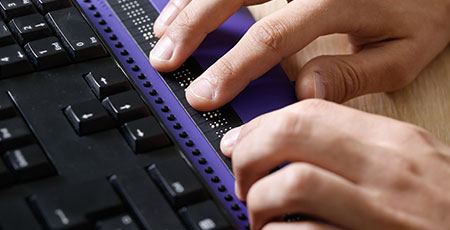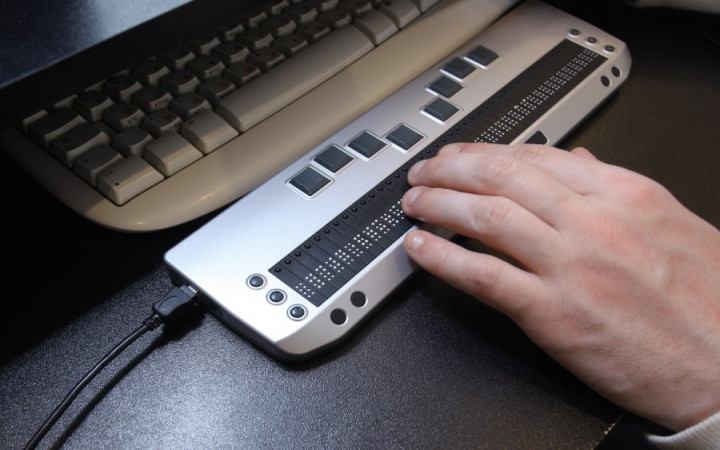Speech-to-Text Devices for Low Vision: Narrowing the Communication Gap
Speech-to-Text Devices for Low Vision: Narrowing the Communication Gap
Blog Article
Empowering Freedom With Assistive Technology for the Blind
The integration of assistive modern technology right into the lives of individuals with visual problems represents a considerable development in advertising independence and self-sufficiency. From innovative screen visitors to innovative wise walking canes, these devices not only boost day-to-day navigating and communication but likewise equip customers to involve meaningfully in different facets of life. As we check out the myriad benefits and real-world applications of these innovations, it ends up being vital to examine the hidden variables that add to their efficiency and the possibility for future developments in this essential field.
Summary of Assistive Modern Technology

The growth of assistive modern technology is based in concepts of inclusivity and empowerment. Technologies in software, hardware, and sensory improvements offer customers with options tailored to their details needs. From display readers that convert message to speech, to responsive gadgets that communicate info with touch, these tools change the method individuals engage with their environments.
In addition to functional applications, assistive technology fosters higher social incorporation and engagement in various markets, including education and work (OCR devices for the blind). As research study and growth continue to develop, the possibility for assistive modern technology to further improve the lives of aesthetically impaired individuals continues to be encouraging, leading the way for an extra fair culture where every person can grow
Kinds Of Assistive Instruments
A range of assistive gadgets have actually emerged to support people with aesthetic problems, each made to fulfill certain demands and improve daily performance. These devices vary from low-tech solutions to modern innovations, supplying varied choices for customers.
Low-tech gadgets consist of magnifiers and large-print products that aid in analysis and writing. Braille devices, such as Braille styluses and slates, enable tactile reading and communication. Alignment and mobility help, like white canes, aid customers navigate their atmosphere safely.
On the higher end of the spectrum, electronic zoom systems and display viewers supply significant assistance. Digital magnifiers enable customers to increase the size of message and pictures on screens, while screen viewers transform digital material right into synthesized speech, facilitating access to details on computer systems and smart devices.
Mobile phone applications additionally play an important duty, providing features like text acknowledgment and navigation support. Wearable modern technology, such as wise glasses outfitted with increased fact, is arising as an encouraging device to improve situational understanding.
Advantages of Assistive Innovation
The integration of assistive modern technology dramatically enhances the lifestyle for people with visual problems. These innovations empower users by advertising freedom, allowing them to browse their environments a lot more efficiently and carry out day-to-day tasks with greater ease. For circumstances, display viewers and zoom software program enable people to access digital information, fostering academic and professional opportunities that see this might have formerly run out reach.
Additionally, assistive tools such as smart canes and general practitioners applications offer real-time navigation aid, improving flexibility and safety and security. This increased freedom not just boosts self-confidence however also urges social involvement, allowing individuals to participate more fully in their neighborhoods.
Assistive technology likewise assists in interaction, assisting users get in touch with others via voice acknowledgment and text-to-speech applications. This capacity is vital for keeping relationships and accessing critical information.
Additionally, the modification options offered with many assistive modern technologies guarantee that individuals can customize tools to their details demands, further boosting usability and effectiveness. Generally, the benefits of assistive technology for people with visual disabilities are extensive, promoting a much more comprehensive culture where everyone can pursue their aspirations and goals.
Study and Success Stories
Highlighting the transformative influence of assistive innovation, various case research studies illustrate just how individuals with aesthetic disabilities have actually efficiently integrated these devices right into their day-to-day lives. One compelling instance includes an university trainee that utilized screen reading software to navigate on-line sources and scholastic materials efficiently. This modern technology not only facilitated her education and learning yet additionally boosted her confidence in participating in conversations and team jobs.
An additional study includes a specialist that employs a mobile phone application designed for navigation and things recognition. By utilizing this application, he has actually restored autonomy in both his individual and workplace, permitting him to commute individually and engage with colleagues more efficiently.
Furthermore, a retiree shared her experience with braille e-readers, which allowed her to access a large variety of literary works and remain connected with her area with book clubs.
These success tales underscore the vital role of assistive modern technology in fostering independence, enhancing lifestyle, and promoting social integration for individuals with visual impairments (Smart glasses for the visually impaired). By accepting these innovative devices, individuals can overcome difficulties and confiscate possibilities that add to their expert and individual gratification

Future Trends in Assistive Technology
Development in assistive innovation is poised to redefine the landscape of assistance for individuals with visual impairments. Emerging patterns emphasize the integration of expert system (AI) and artificial intelligence, which boost the performance of gadgets that aid with navigation and info accessibility. AI-driven applications are now capable of interpreting aesthetic data in real-time, enabling customers to engage with their setting extra individually.
Furthermore, the development of wearable technology is advancing rapidly. Smart glasses equipped with enhanced fact (AR) can give audio summaries of surroundings, changing how individuals communicate with public rooms. These gadgets dry eye disease not only promote freedom but additionally foster social inclusion.
Additionally, the Internet of Points (IoT) is making homes smarter, enabling for smooth connection in between day-to-day appliances and assistive gadgets. This connection encourages users by allowing voice-activated controls and computerized actions tailored to individual needs.
Final Thought
To conclude, assistive technology plays a crucial duty in empowering people with visual problems by improving their self-reliance and engagement with their surroundings. The diverse variety of tools and applications available not just promotes navigation and interaction yet likewise advertises social integration and opportunities for specialist and personal growth. As improvements continue in this field, the potential for boosting from this source the lifestyle for those with visual impairments will certainly expand, promoting higher autonomy and empowerment.

Report this page